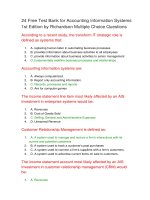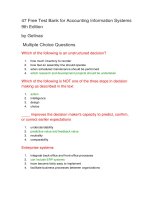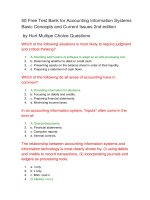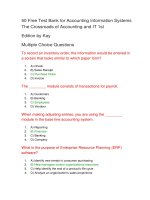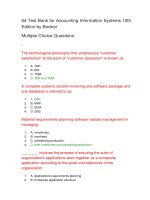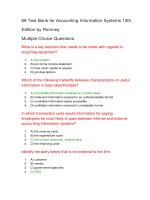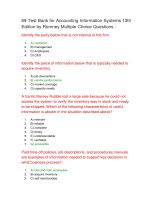104 test bank for accounting 8th
Bạn đang xem bản rút gọn của tài liệu. Xem và tải ngay bản đầy đủ của tài liệu tại đây (116.69 KB, 29 trang )
104 Test Bank for Accounting 8th
True-False Questions
The income statement must be prepared before the statement of owner's
equity since net income or net loss is added to or subtracted from the
beginning balance in the owner's capital account.
1.
True
2.
False
The income statement presents a summary of an entity's revenues and
liabilities over a period of time.
1.
True
2.
False
One way of increasing the equity of a business is to increase a liability.
1.
True
2.
False
The income statement shows how much the cash account either increased or
decreased during the period.
1.
True
2.
False
The accounting equation can be stated as assets + liabilities = owner's equity.
1.
True
2.
False
Financial statements provide information about business activities to decision
makers.
1.
True
2.
False
Assets are economic resources of a business expected to be of benefit in the
future.
1.
True
2.
False
The going-concern assumption states an entity will remain in operation for
only the next accounting period.
1.
True
2.
False
The recording of an owner withdrawal has the same effect on owner's equity
as the recording of an owner investment.
1.
True
2.
False
The purchase of supplies on account would have an effect on the owner's
equity of the firm.
1.
True
2.
False
Increases in owner's equity result from revenues and owner investments
while decreases result from expenses and owner withdrawals.
1.
True
2.
False
The designation CA stands for Certified Public Accountant.
1.
True
2.
False
Investors provide money to a business to begin operations.
1.
True
2.
False
When a revenue is recorded, the asset account Cash is always increased
along with owner's equity.
1.
True
2.
False
An organization, for accounting purposes, stands apart from other
organizations and individuals as a separate accounting entity.
1.
True
2.
False
An income statement is dated for a period of time such as "For the Year
Ended December 31, 2010."
1.
True
2.
False
Owner's equity is often referred to as net assets and represents the residual
amount of business assets, which can be claimed by the owner.
1.
True
2.
False
A proprietorship can have two owners, so long as they are husband and wife.
1.
True
2.
False
Not-for-profit organizations need accounting information, as do profit-oriented
organizations.
1.
True
2.
False
The balance sheet lists all the entity's assets, liabilities, and owner's equity as
of a specific date.
1.
True
2.
False
The reliability characteristic means that accounting information is free from
error and bias, i.e., objective.
1.
True
2.
False
An owner investment would increase the assets and decrease the liabilities of
the firm.
1.
True
2.
False
Multiple Choice Questions-Page 1
All of the following are forms of business organizations except:
1.
A. proprietorship
2.
B. partnership
3.
C. corporation
4.
D. governmental unit
Which of the following is not addressed by rules of professional conduct?
1.
A. competence
2.
B. confidentiality
3.
C. number of clients
4.
D. compliance with professional standards
If total liabilities decrease by $22,000 and owner's equity increases by $8,000
during the period, then assets must have:
1.
A. increased $30,000
2.
B. decreased $30,000
3.
C. increased $14,000
4.
D. decreased $14,000
According to GAAP, the primary objective of financial reporting is to provide
information:
1.
A. to the federal government
2.
B. about the profitability of the business
3.
C. regarding the cash flows of the business
4.
D. useful for making investment decisions and for assessing management's
stewardship
A promise by a customer to pay cash in the future is a(n.:
1.
A. account receivable
2.
B. liability
3.
C. prepaid asset
4.
D. note payable
If owner's equity is $135,000 and total liabilities are $90,000, then total assets
would be:
1.
A. $45,000
2.
B. $225,000
3.
C. $90,000
4.
D. $135,000
Earning a revenue and immediately collecting the related cash would:
1.
A. decrease total assets
2.
B. have no effect on owner's equity
3.
C. have no effect on total assets
4.
D. increase owner's equity
Which of the following statements is false?
1.
A. Reliable data are verifiable.
2.
B. Reliable data may be supported by objective evidence.
3.
C. Owner opinions are one source of objective evidence.
4.
D. An independent appraisal is usually considered reliable.
The Sarbanes-Oxley Act became law in response to
1.
A. high profits of publicly traded companies
2.
B. exorbitant fees charged by public accounting firms
3.
C. unethical behaviour that caused huge accounting scandals
4.
D. investor demands for increased control over private companies
The qualitative characteristic that states that accounting records and
statements are based on the most reliable data available so they are are as
accurate and useful as possible.
1.
A. Reliability
2.
B. Relevance
3.
C. Comparability
4.
D. Understandability
The relevant measure of value of the assets of a company that is going out of
business is their:
1.
A. current market value
2.
B. book value
3.
C. historical cost
4.
D. higher of historical cost or current market value
The amount owed by an entity when it makes a purchase on account is
termed a(n.:
1.
A. accounts receivable
2.
B. accounts payable
3.
C. note receivable
4.
D. note payable
Earning revenue on account:
1.
A. decreases assets
2.
B. increases liabilities
3.
C. decreases owner's equity
4.
D. increases owner's equity
Liabilities are:
1.
A. insider claims to the business's assets
2.
B. outsider claims to the business's assets
3.
C. economic resources of a business
4.
D. increases in owner's equity earned by delivering goods or services
According to GAAP, to be useful, accounting information must be all of the
following except:
1.
A. relevant
2.
B. comparable
3.
C. subjective
4.
D. reliable
All of the following describe a liability except:
1.
A. investments by owners
2.
B. economic obligations to creditors
3.
C. debts to creditors
4.
D. outsider claims
Owner's equity and total assets were $32,000 and $79,000 respectively at the
beginning of the period. Assets increased 50% and liabilities decreased 60%
during the period. What is owner's equity at the end of the period?
1.
A. $47,000
2.
B. $43,300
3.
C. $99,700
4.
D. $105,700
Purchasing office equipment on account would:
1.
A. decrease owner's equity
2.
B. increase owner's equity
3.
C. have no effect on owner's equity
4.
D. decrease liabilities
On December 31, the assets of a business include: Cash, $3,500, Accounts
Receivable, $14,000, and Supplies, $1,050. The liabilities on December 31 total
$7,600. The owner's equity on December 31 is:
1.
A. $18,550
2.
B. $25,100
3.
C. $10,950
4.
D. $11,100
A business paid $8,500 to a creditor. The effect of this transaction is to:
1.
A. increase assets and decrease liabilities
2.
B. increase assets and decrease owner's equity
3.
C. decrease liabilities and owner's equity
4.
D. decrease assets and decrease liabilities
Which of the following users of accounting information seek to assess the
organization's ability to make scheduled payments?
1.
A. creditors
2.
B. taxing authorities
3.
C. government regulatory agencies
4.
D. employees
The Accounting Standards Board is responsible for establishing:
1.
A. the Canadian Institute of Chartered Accountants
2.
B. generally accepted accounting principles
3.
C. the code of professional conduct for accountants
4.
D. the Securities and Exchange Commission
GAAP stands for:
1.
A. generally accepted auditing practices
2.
B. generally accrued auditing procedures
3.
C. generally accepted accounting principles
4.
D. generally accrued accounting principles
Owner's equity is an:
1.
A. insider claim to the business's assets
2.
B. outsider claim to the business's assets
3.
C. economic resources of a business
4.
D. obligation to pay cash in the future
Which of the following statements is true?
1.
A. The value of a dollar changes over time.
2.
B. German accountants record transactions in dollars.
3.
C. The stable-monetary-unit concept requires adjustments to the accounting records
for the effects of inflation.
4.
D. High inflation rates indicate a dollar's purchasing power is stable.
All of the following are assets except:
1.
A. land
2.
B. cash
3.
C. merchandise inventory
4.
D. owner withdrawals
Which of the following forms of business organizations protect the personal
assets of the owners from creditors of the business?
1.
A. proprietorship
2.
B. partnership
3.
C. corporation
4.
D. corporation and partnership
Collection of an account receivable would:
1.
A. decrease liabilities
2.
B. have no effect on owner's equity
3.
C. decrease owner's equity
4.
D. increase total assets
Borrowing money from a bank would:
1.
A. have no effect on owner's equity
2.
B. decrease assets
3.
C. decrease liabilities
4.
D. increase revenues
If owner's equity is $200,000 and total assets are $325,000, total liabilities
would be:
1.
A. $200,000
2.
B. $525,000
3.
C. $125,000
4.
D. $325,000
The payment of an account payable would:
1.
A. increase owner's equity
2.
B. decrease owner's equity
3.
C. have no effect on total assets
4.
D. have no effect on owner's equity
Total assets and total liabilities were $31,000 and $26,000 respectively at the
beginning of the period. Assets increased by 20% and liabilities increased by
10% during the period. What is the owner's equity at the end of the period?
1.
A. $8,600
2.
B. $65,800
3.
C. $290
4.
D. $5,000
If total liabilities are $98,000 and owner's equity is $150,000, total assets would
be:
1.
A. $52,000
2.
B. $248,000
3.
C. $98,000
4.
D. $300,000
Transactions affecting owner's equity include:
1.
A. owner withdrawals and owner investments
2.
B. purchases of assets for cash
3.
C. purchases of assets on account
4.
D. only owner investments
Purchasing a parcel of land for $100,000 by paying $10,000 in cash and
signing a promissory note for the remainder would:
1.
A. decrease owner's equity by $90,000
2.
B. increase owner's equity by $10,000
3.
C. decrease liabilities by $90,000
4.
D. increase total assets by $90,000
The principle that states that assets acquired by the business should be
recorded at their exchange price is the:
1.
A. objectivity principle
2.
B. cost principle of measurement
3.
C. revenue-recognition principle
4.
D. matching principle
The accounting equation can be stated as:
1.
A. Assets = Liabilities - Owner's Equity
2.
B. Assets - Liabilities = Owner's Equity
3.
C. Liabilities = Assets + Owner's Equity
4.
D. Owner's Equity = Assets + Liabilities
72 Free Test Bank for Accounting 8th Canadian Edition
by Horngren Multiple Choice Questions-Page 2
Earning a revenue on account would:
1.
A. have no effect on owner's equity
2.
B. increase owner's equity
3.
C. decrease owner's equity
4.
D. decrease total assets
Liabilities are reported on the:
1.
A. statement of owner's equity
2.
B. income statement
3.
C. statement of owner's equity and the income statement
4.
D. balance sheet
The financial statement that presents a summary of the assets, liabilities, and
owner's equity as of a specific date is the:
1.
A. statement of assets
2.
B. balance sheet
3.
C. statement of owner's equity
4.
D. cash flow statement
Which of the following financial statements reports owner's equity as of the
end of the accounting period?
1.
A. income statement and the balance sheet
2.
B. cash flow statement and the balance sheet
3.
C. statement of owner's equity and the balance sheet
4.
D. cash flow statement and the income statement
Purchasing supplies for cash would:
1.
A. decrease total assets and decrease owner's equity
2.
B. increase total assets and increase liabilities
3.
C. decrease liabilities and decrease total assets
4.
D. have no effect on total assets
Collecting cash on account causes:
1.
A. assets to increase and owner's equity to decrease
2.
B. assets to increase and liabilities to increase
3.
C. assets to increase and owner's equity to increase
4.
D. no change in total assets
An owner investment of office furniture into the business would:
1.
A. decrease owner's equity and decrease liabilities
2.
B. increase total assets and increase liabilities
3.
C. increase owner's equity and increase total assets
4.
D. decrease owner's equity and increase liabilities
Assets are reported on the:
1.
A. income statement
2.
B. income statement and balance sheet
3.
C. statement of owner's equity
4.
D. balance sheet
Which of the following transactions would both increase and decrease an
asset?
1.
A. purchasing equipment for cash
2.
B. borrowing money from a bank
3.
C. performing a service and receiving the cash immediately
4.
D. purchasing office supplies on account
The statement that presents a summary of the revenues and expenses of an
entity is called the:
1.
A. statement of owner's equity
2.
B. statement of financial position
3.
C. income statement
4.
D. balance sheet
Receiving cash from a customer in payment of an account receivable would:
1.
A. decrease total assets and increase owner's equity
2.
B. increase owner's equity and increase liabilities
3.
C. increase total assets and decrease liabilities
4.
D. have no effect on total assets or owner's equity
A cash investment into the business by the owner would:
1.
A. increase liabilities and increase owner's equity
2.
B. increase total assets and decrease owner's equity
3.
C. increase owner's equity and increase total assets
4.
D. increase total assets and decrease liabilities
Performing a service on account would:
1.
A. increase liabilities and decrease total assets
2.
B. decrease liabilities and increase total assets
3.
C. increase owner's equity and decrease liabilities
4.
D. increase total assets and increase owner's equity
Determine cash withdrawals for the period if net income is $34,000, beginning
owner's equity is $29,000, and ending owner's equity is $45,000.
1.
A. $74,000
2.
B. $5,000
3.
C. $11,000
4.
D. $18,000
Borrowing money and signing a note payable would:
1.
A. increase total assets and increase liabilities
2.
B. decrease liabilities and increase total assets
3.
C. increase liabilities and increase owner's equity
4.
D. increase total assets and increase owner's equity
Determine net income for the period if beginning owner's equity is $20,000,
cash withdrawals by the owner amount to $7,000, and ending owner's equity
is $37,000.
1.
A. $10,000
2.
B. $27,000
3.
C. $24,000
4.
D. $13,000
Which of the following transactions would increase one asset, decrease
another asset, and increase a liability?
1.
A. purchasing supplies and equipment on account
2.
B. paying liabilities incurred last period
3.
C. owner investment of cash and equipment into the business
4.
D. purchasing land with a cash down payment and a note payable
If beginning capital was $25,000, ending capital is $37,000, and the owner's
withdrawals were $23,000, the amount of net income or net loss for the period
was:
1.
A. net loss of $35,000
2.
B. net income of $35,000
3.
C. net income of $14,000
4.
D. net loss of $14,000
Purchasing a building for $120,000 by paying cash of $30,000 and obtaining a
mortgage for $90,000 would:
1.
A. increase assets and increase liabilities by $90,000
2.
B. increase owner's equity by $90,000
3.
C. increase liabilities by $30,000
4.
D. decrease assets and decrease liabilities by $30,000
The income statement presents a summary of the:
1.
A. cash inflows and outflows of an entity
2.
B. revenues and expenses of an entity
3.
C. assets and liabilities of an entity
4.
D. changes that occurred in the owner's equity of an entity
A business acquires a parcel of land by issuing a note payable for $50,000.
This transaction causes:
1.
A. total assets to increase
2.
B. owner's equity to increase
3.
C. assets to increase and equity to increase
4.
D. liabilities to decrease
Which of the following transactions would increase an asset and increase
owner's equity?
1.
A. payment of a note payable
2.
B. receipt of cash in payment of an account receivable
3.
C. owner investment of land into the business
4.
D. payment of the telephone bill
Purchasing a building for $150,000 by paying cash of $30,000 and obtaining a
mortgage for $120,000 would:
1.
A. increase assets and liabilities by $120,000
2.
B. increase liabilities by $120,000
3.
C. increase liabilities by $30,000
4.
D. decrease assets and liabilities by $120,000
Receiving cash for services performed the same day would:
1.
A. increase owner's equity and decrease total assets
2.
B. decrease total assets and decrease liabilities
3.
C. increase liabilities and increase total assets
4.
D. increase owner's equity and have no effect on liabilities
The payment of rent each month for office space would:
1.
A. increase total assets
2.
B. increase owner's equity
3.
C. decrease liabilities
4.
D. increase expenses
Total assets at the end of the period were $330,000 and liabilities were 25% of
owner's equity. Determine owner's equity at the end of the period.
1.
A. $264,000
2.
B. $132,000
3.
C. $462,000
4.
D. $825,000
A business receives its bill for utilities for the current month that it plans to
pay next month when the payment is due. This transaction causes:
1.
A. an increase in both assets and owner's equity
2.
B. a decrease in both owner's equity and liabilities
3.
C. an increase in both assets and liabilities
4.
D. an increase in liabilities and a decrease in owner's equity
A withdrawal of cash for personal use by an owner would:
1.
A. decrease total assets and decrease owner's equity
2.
B. increase owner's equity and increase liabilities
3.
C. decrease total assets and increase owner's equity
4.
D. increase total assets and decrease owner's equity
Which of the following statements should be prepared before the balance
sheet is prepared?
1.
A. statement of owner's equity
2.
B. statement of financial position
3.
C. income statement
4.
D. statement of owner's equity and income statement
Which of the following transactions would increase an asset and increase a
liability?
1.
A. payment of an account payable
2.
B. borrowing money from a bank
3.
C. an owner investment of cash into the business
4.
D. purchasing office equipment for cash
Purchasing office equipment on account would:
1.
A. increase total assets and increase liabilities
2.
B. increase total assets and decrease owner's equity
3.
C. have no effect on total assets or liabilities
4.
D. increase liabilities and decrease owner's equity
Cash investments by the owner are reported on the:
1.
A. balance sheet
2.
B. income statement
3.
C. cash flow statement
4.
D. income statement and the balance sheet
Earning a revenue on account would:
1.
A. have no effect on liabilities
2.
B. decrease owner's equity
3.
C. increase accounts receivable
4.
D. decrease total assets
A cash payment of an account payable would:
1.
A. decrease total assets and decrease owner's equity
2.
B. increase total assets and decrease liabilities
3.
C. have no effect on total assets
4.
D. decrease liabilities and decrease assets
Which of the following transactions would have no effect on total assets, total
liabilities, or owner's equity?
1.
A. payment of a liability
2.
B. borrowing cash by issuing a note payable
3.
C. purchasing supplies for cash
4.
D. purchasing supplies on account
